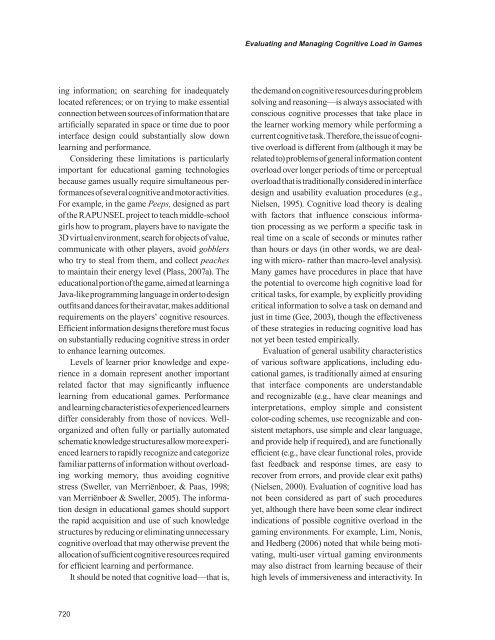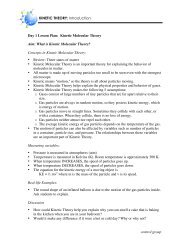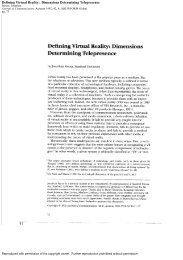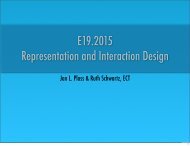Evaluating and managing cognitive load in educational games
Evaluating and managing cognitive load in educational games
Evaluating and managing cognitive load in educational games
Create successful ePaper yourself
Turn your PDF publications into a flip-book with our unique Google optimized e-Paper software.
<strong>Evaluat<strong>in</strong>g</strong> <strong>and</strong> Manag<strong>in</strong>g Cognitive Load <strong>in</strong> Games<br />
<strong>in</strong>g <strong>in</strong>formation; on search<strong>in</strong>g for <strong>in</strong>adequately<br />
located references; or on try<strong>in</strong>g to make essential<br />
connection between sources of <strong>in</strong>formation that are<br />
artificially separated <strong>in</strong> space or time due to poor<br />
<strong>in</strong>terface design could substantially slow down<br />
learn<strong>in</strong>g <strong>and</strong> performance.<br />
Consider<strong>in</strong>g these limitations is particularly<br />
important for <strong>educational</strong> gam<strong>in</strong>g technologies<br />
because <strong>games</strong> usually require simultaneous performances<br />
of several <strong>cognitive</strong> <strong>and</strong> motor activities.<br />
For example, <strong>in</strong> the game Peeps, designed as part<br />
of the RAPUNSEL project to teach middle-school<br />
girls how to program, players have to navigate the<br />
3D virtual environment, search for objects of value,<br />
communicate with other players, avoid gobblers<br />
who try to steal from them, <strong>and</strong> collect peaches<br />
to ma<strong>in</strong>ta<strong>in</strong> their energy level (Plass, 2007a). The<br />
<strong>educational</strong> portion of the game, aimed at learn<strong>in</strong>g a<br />
Java-like programm<strong>in</strong>g language <strong>in</strong> order to design<br />
outfits <strong>and</strong> dances for their avatar, makes additional<br />
requirements on the players’ <strong>cognitive</strong> resources.<br />
Efficient <strong>in</strong>formation designs therefore must focus<br />
on substantially reduc<strong>in</strong>g <strong>cognitive</strong> stress <strong>in</strong> order<br />
to enhance learn<strong>in</strong>g outcomes.<br />
Levels of learner prior knowledge <strong>and</strong> experience<br />
<strong>in</strong> a doma<strong>in</strong> represent another important<br />
related factor that may significantly <strong>in</strong>fluence<br />
learn<strong>in</strong>g from <strong>educational</strong> <strong>games</strong>. Performance<br />
<strong>and</strong> learn<strong>in</strong>g characteristics of experienced learners<br />
differ considerably from those of novices. Wellorganized<br />
<strong>and</strong> often fully or partially automated<br />
schematic knowledge structures allow more experienced<br />
learners to rapidly recognize <strong>and</strong> categorize<br />
familiar patterns of <strong>in</strong>formation without over<strong>load</strong><strong>in</strong>g<br />
work<strong>in</strong>g memory, thus avoid<strong>in</strong>g <strong>cognitive</strong><br />
stress (Sweller, van Merriënboer, & Paas, 1998;<br />
van Merriënboer & Sweller, 2005). The <strong>in</strong>formation<br />
design <strong>in</strong> <strong>educational</strong> <strong>games</strong> should support<br />
the rapid acquisition <strong>and</strong> use of such knowledge<br />
structures by reduc<strong>in</strong>g or elim<strong>in</strong>at<strong>in</strong>g unnecessary<br />
<strong>cognitive</strong> over<strong>load</strong> that may otherwise prevent the<br />
allocation of sufficient <strong>cognitive</strong> resources required<br />
for efficient learn<strong>in</strong>g <strong>and</strong> performance.<br />
It should be noted that <strong>cognitive</strong> <strong>load</strong>—that is,<br />
the dem<strong>and</strong> on <strong>cognitive</strong> resources dur<strong>in</strong>g problem<br />
solv<strong>in</strong>g <strong>and</strong> reason<strong>in</strong>g—is always associated with<br />
conscious <strong>cognitive</strong> processes that take place <strong>in</strong><br />
the learner work<strong>in</strong>g memory while perform<strong>in</strong>g a<br />
current <strong>cognitive</strong> task. Therefore, the issue of <strong>cognitive</strong><br />
over<strong>load</strong> is different from (although it may be<br />
related to) problems of general <strong>in</strong>formation content<br />
over<strong>load</strong> over longer periods of time or perceptual<br />
over<strong>load</strong> that is traditionally considered <strong>in</strong> <strong>in</strong>terface<br />
design <strong>and</strong> usability evaluation procedures (e.g.,<br />
Nielsen, 1995). Cognitive <strong>load</strong> theory is deal<strong>in</strong>g<br />
with factors that <strong>in</strong>fluence conscious <strong>in</strong>formation<br />
process<strong>in</strong>g as we perform a specific task <strong>in</strong><br />
real time on a scale of seconds or m<strong>in</strong>utes rather<br />
than hours or days (<strong>in</strong> other words, we are deal<strong>in</strong>g<br />
with micro- rather than macro-level analysis).<br />
Many <strong>games</strong> have procedures <strong>in</strong> place that have<br />
the potential to overcome high <strong>cognitive</strong> <strong>load</strong> for<br />
critical tasks, for example, by explicitly provid<strong>in</strong>g<br />
critical <strong>in</strong>formation to solve a task on dem<strong>and</strong> <strong>and</strong><br />
just <strong>in</strong> time (Gee, 2003), though the effectiveness<br />
of these strategies <strong>in</strong> reduc<strong>in</strong>g <strong>cognitive</strong> <strong>load</strong> has<br />
not yet been tested empirically.<br />
Evaluation of general usability characteristics<br />
of various software applications, <strong>in</strong>clud<strong>in</strong>g <strong>educational</strong><br />
<strong>games</strong>, is traditionally aimed at ensur<strong>in</strong>g<br />
that <strong>in</strong>terface components are underst<strong>and</strong>able<br />
<strong>and</strong> recognizable (e.g., have clear mean<strong>in</strong>gs <strong>and</strong><br />
<strong>in</strong>terpretations, employ simple <strong>and</strong> consistent<br />
color-cod<strong>in</strong>g schemes, use recognizable <strong>and</strong> consistent<br />
metaphors, use simple <strong>and</strong> clear language,<br />
<strong>and</strong> provide help if required), <strong>and</strong> are functionally<br />
efficient (e.g., have clear functional roles, provide<br />
fast feedback <strong>and</strong> response times, are easy to<br />
recover from errors, <strong>and</strong> provide clear exit paths)<br />
(Nielsen, 2000). Evaluation of <strong>cognitive</strong> <strong>load</strong> has<br />
not been considered as part of such procedures<br />
yet, although there have been some clear <strong>in</strong>direct<br />
<strong>in</strong>dications of possible <strong>cognitive</strong> over<strong>load</strong> <strong>in</strong> the<br />
gam<strong>in</strong>g environments. For example, Lim, Nonis,<br />
<strong>and</strong> Hedberg (2006) noted that while be<strong>in</strong>g motivat<strong>in</strong>g,<br />
multi-user virtual gam<strong>in</strong>g environments<br />
may also distract from learn<strong>in</strong>g because of their<br />
high levels of immersiveness <strong>and</strong> <strong>in</strong>teractivity. In<br />
720








